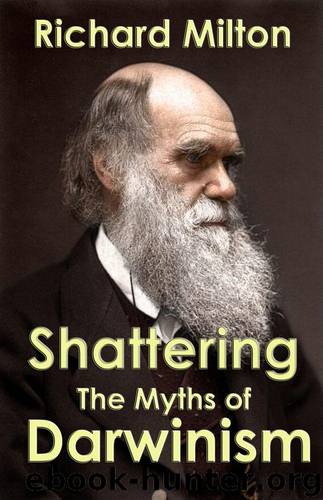Shattering the Myths of Darwinism: A rational criticism of evolution theory by Richard Milton

Author:Richard Milton
Language: eng
Format: mobi, epub
Published: 2015-03-11T00:00:00+00:00
Chapter 14
Of Cabbages and Kings
The instructions for reproduction of a cabbage or a king are contained in dark threadlike strands in the nucleus of its cells, called chromosomes, which are long molecules of DNA sheathed in protein. The instructions themselves consist of sequences of four chemical groups, called nucleotides, strung like clothes on a washing line and identified by their initial letters - C, T, A and G (cytosine, thymine, adenine and guanine).
The genetic meaning of each sequence - the kind of physical characteristic it gives its owner - depends on the sequence of nucleotides (C, T, A and G) and the position of that sequence on the 'washing line'. The sequence TCA for example is the genetic code for an amino acid called serine which is important in building membranes. The sequence CCA is the code which causes the synthesis of an amino acid called proline which is widely used in building connective tissues.
Not surprisingly, the total number of instructions, or sequences, in an organism as complex as a human runs into millions - too many in fact for one chromosome. Each chromosome is like a magnetic tape; but there are so many instructions they run over onto another tape, and another. In humans there are 23 chromosomes in the 'tape library'. In the fruit fly there are 4, while the humble land snail has 27 and, curiously, the simple goldfish has 47. When she wrote that a rose is a rose is a rose, Gertrude Stein must have been unaware that roses exist with 14, 21, 28, 35 and 56 chromosomes.
However, despite the genetic code taking up so much room (actually a chromosome is only one-hundredth of a millimeter long) some 90 per cent of the recording space in the tape library is empty. The genetic instructions which actually cause the manufacture of proteins occupy only 10 per cent of the available coding space. Or to be more exact, only ten per cent of the sequences in the chromosomes cause anything to be replicated. The function of the other 90 per cent of sequences is unknown at present. Although it does not replicate, it may affect the positioning (and hence the genetic meaning) of the sections that do replicate.
While enough is known of the genetic code to justify saying that geneticists understand it in principle, much of it remains mysterious. Unfortunately, it is not a simple case of a single gene, at a single location, controlling a single characteristic. Various locations are linked together to control groups of characteristics in a non-obvious way.
In sexual reproduction, when a male sperm unites with a female egg, the DNA molecules of each split apart, like a zipper unzipping, and cross-join to form the set of chromosomes of the first cell of the new individual. Also, when the first cell divides and redivides to form the new embryo, the DNA molecules unzip and replicate themselves exactly, thus perpetuating the program or building instructions in every cell of the new individual both for its embryonic form and for life.
Download
Shattering the Myths of Darwinism: A rational criticism of evolution theory by Richard Milton.epub
This site does not store any files on its server. We only index and link to content provided by other sites. Please contact the content providers to delete copyright contents if any and email us, we'll remove relevant links or contents immediately.
| Anatomy | Animals |
| Bacteriology | Biochemistry |
| Bioelectricity | Bioinformatics |
| Biology | Biophysics |
| Biotechnology | Botany |
| Ecology | Genetics |
| Paleontology | Plants |
| Taxonomic Classification | Zoology |
Sapiens: A Brief History of Humankind by Yuval Noah Harari(14322)
The Tidewater Tales by John Barth(12627)
Mastermind: How to Think Like Sherlock Holmes by Maria Konnikova(7281)
Do No Harm Stories of Life, Death and Brain Surgery by Henry Marsh(6908)
The Thirst by Nesbo Jo(6882)
Why We Sleep: Unlocking the Power of Sleep and Dreams by Matthew Walker(6659)
Life 3.0: Being Human in the Age of Artificial Intelligence by Tegmark Max(5519)
Sapiens by Yuval Noah Harari(5325)
The Longevity Diet by Valter Longo(5044)
The Body: A Guide for Occupants by Bill Bryson(5033)
The Rules Do Not Apply by Ariel Levy(4912)
The Immortal Life of Henrietta Lacks by Rebecca Skloot(4552)
Animal Frequency by Melissa Alvarez(4430)
Why We Sleep by Matthew Walker(4395)
The Hacking of the American Mind by Robert H. Lustig(4342)
Yoga Anatomy by Kaminoff Leslie(4334)
All Creatures Great and Small by James Herriot(4277)
Double Down (Diary of a Wimpy Kid Book 11) by Jeff Kinney(4244)
Embedded Programming with Modern C++ Cookbook by Igor Viarheichyk(4143)
